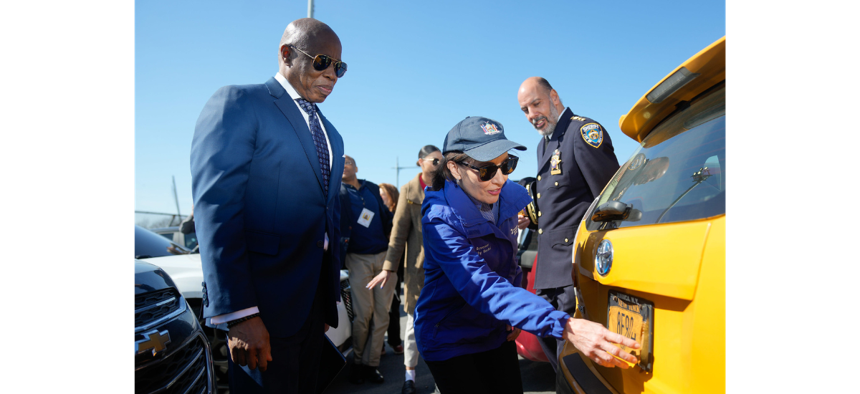Opinion
Opinion: Slaying New York’s two-headed monster driving up car insurance costs
The city and state must increase enforcement against garaging fraud and “ghost cars,” the illegal practices responsible for New York’s extremely high car insurance costs.

Gov. Kathy Hochul peels a fake license plate off of a “ghost car” while Mayor Eric Adams (left) looks on. Michael Appleton/Mayoral Photography Office
While national headlines focus on rising gas prices and groceries, New Yorkers face an even steeper financial burden on the road. Our persistent battle with inflation is being fueled by skyrocketing auto insurance rates. In the past year, the average car insurance premium has gone up 26%.
The national average for auto insurance sits at a relatively manageable $1,982 annually. But here in New York, drivers pay more than twice as much – a burden of $4,527 a year. Our outlier status becomes even more noticeable when compared to other large states: In North Carolina, it’s $1,307; in Virginia, it’s $1,486; and in Pennsylvania, it’s $3,292.
This disparity isn’t caused by a random quirk. Two significant contributors to New York’s high insurance rates are the double headed monster of garaging fraud and ghost cars.
Garaging fraud is when New Yorkers illegally register their vehicles in other states to avoid exorbitant local insurance premiums. A review of the New York City Department of Finance’s 2023 parking and camera violation data highlights the scope of this problem. Last year, the city issued 4.4 million citations involving vehicles with out-of-state plates.
Faced with astronomical insurance costs, some residents may feel compelled to resort to this unlawful workaround – registering their vehicles at previous homes or at their grandparents’ condo in Ohio. This not only violates the law but also creates a vicious cycle. The influx of out-of-state registrations distorts the customer pool for in-state insurers. With a seemingly higher-risk pool of drivers, insurers become wary and charge even more for coverage for everyone else. This further incentivizes even more residents to seek out-of-state registration, perpetuating the cycle and leaving law-abiding New Yorkers footing a disproportionately higher bill.
Adding another layer of complexity to the issue is the rise of “ghost cars.” These are vehicles with forged or altered license plates, often used to avoid paying insurance altogether, evade tolls, tickets and even serious crimes. These shadowy vehicles not only pose a safety risk but also contribute to higher insurance costs. Unregistered and untraceable, ghost cars operate outside the legal system, creating a blind spot for law enforcement and insurance companies alike. Without a clear picture of risk on the roads, insurers are forced to spread the cost burden all across the board, inflating premiums even further.
For consumers, there is some cause for optimism. The formation of a multi-agency task force targeting ghost cars demonstrates the effectiveness of a strong, coordinated effort that – along with legislative action – could serve as a model for how to address this problem holistically.
Announced by Gov. Kathy Hochul and Mayor Adams, a recent operation involving the NYPD, New York State Police, the New York State Department of Motor Vehicles and other agencies impounded 73 vehicles, issued 282 summonses and made eight arrests. This crackdown not only removed dangerous vehicles from the streets but also sent a powerful message: New York should not tolerate attempts to evade the law through ghost cars.
Likewise, stronger enforcement actions by the same city and state agencies can be harnessed to address garaging fraud. Our police force is the best in the world, but more resources must be dedicated to addressing this insidious problem. There must also be stricter penalties when garaging fraud is uncovered, because making it harder for individuals to exploit the system will deter future violations. Streamlined data sharing between states and municipalities could also make a big difference in tracking and identifying illegal activity. If that is not enough, New York’s city and state governments should consider taking legislative action to address this issue – and my office is actively working on solutions that will achieve that goal.
One thing is clear: car insurance costs are too damn high. Exorbitant insurance rates stifle businesses, drive professionals away and make New York less competitive. The two-headed monster of garaging fraud and ghost cars has been squeezing New York drivers for far too long. By tackling both of these interconnected cost drivers through city and state collaboration, we can slay the beast and finally push down crushing insurance rates for everyday New Yorkers.
Bob Holden is a City Council member representing Maspeth, Middle Village, Glendale, Elmhurst and Rego Park in Queens.

NEXT STORY: Opinion: Nationwide, LGBTQ+ young people are in crisis. New York can do something about it.